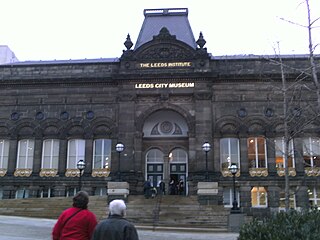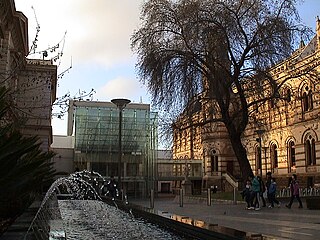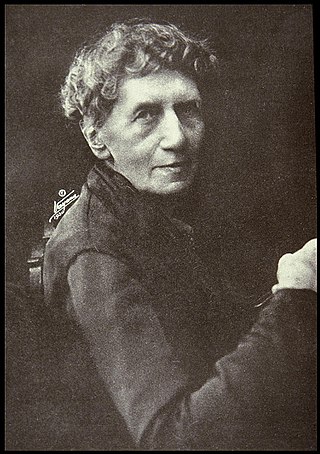Related Research Articles

Mechanics' institutes, also known as mechanics' institutions, sometimes simply known as institutes, and also called schools of arts, were educational establishments originally formed to provide adult education, particularly in technical subjects, to working men in Victorian-era Britain and its colonies. They were often funded by local industrialists on the grounds that they would ultimately benefit from having more knowledgeable and skilled employees. The mechanics' institutes often included libraries for the adult working class, and were said to provide them with an alternative pastime to gambling and drinking in pubs.

The Institut canadien de Montréal was founded on 17 December 1844, by a group of 200 young liberal professionals in Montreal, Canada East, Province of Canada. The Institute provided a public library and debating room for its members. At the time, there were no French-language universities nor public libraries in Montreal. Between 1845 and 1871, some 136 lectures were held inside the Institute's walls. The Institute eventually came into conflict with the Roman Catholic Church over the contents of its library. Partly as a result of the dispute with the Church, the Institute eventually folded in the 1870s.

The Grand Trunk Railway was a railway system that operated in the Canadian provinces of Quebec and Ontario and in the American states of Connecticut, Maine, Michigan, Massachusetts, New Hampshire, and Vermont. The railway was operated from headquarters in Montreal, Quebec, with corporate headquarters in London, United Kingdom. It cost an estimated $160 million to build. The Grand Trunk system and the Canadian Government Railways were precursors of today's Canadian National Railway.

Vancouver Public Library (VPL) is the public library system for the city of Vancouver, British Columbia. In 2023, VPL had more than 4.6 million visits with patrons borrowing nearly 10.4 million items including: books, ebooks, CDs, DVDs, video games, newspapers and magazines. Across 21 locations and online, VPL serves over 236,000 active members and is the largest public library system in British Columbia.

Charles Melville Hays was the president of the Grand Trunk Railway. He began working in the railroad business as a clerk at the age of 17 and quickly rose through the ranks of management to become the General Manager of the Wabash, St. Louis and Pacific Railway. He became Vice-President of that company in 1889 and remained as such until 1896 when he became General Manager of the Grand Trunk Railway (GTR) of Canada.

Mechanics' Institute is a historic membership library, cultural event center, and chess club housed at 57 Post Street, San Francisco, California. It was founded in 1854 as a mechanics' institute, an educational and cultural institution to serve the vocational needs of out-of-work gold miners. Today the Institute serves readers, writers, downtown employees, students, film lovers, chess players, and others in search of learning and a community for the exchange of ideas.

The State Library of South Australia, or SLSA, formerly known as the Public Library of South Australia, located on North Terrace, Adelaide, is the official library of the Australian state of South Australia. It is the largest public research library in the state, with a collection focus on South Australian information, being the repository of all printed and audiovisual material published in the state, as required by legal deposit legislation. It holds the "South Australiana" collection, which documents South Australia from pre-European settlement to the present day, as well as general reference material in a wide range of formats, including digital, film, sound and video recordings, photographs, and microfiche. Home access to many journals, newspapers and other resources online is available.

A subscription library is a library that is financed by private funds either from membership fees or endowments. Unlike a public library, access is often restricted to members, but access rights can also be given to non-members, such as students.
William McNab was a pioneering railway engineer. He came to Canada as a youth and was educated at the McGill Model School and the Montreal Collegiate School. Upon graduating in 1870, he served in the Engineering Department of the Grand Trunk Railway as an indentured pupil. During this time, he was occupied with the construction of the International Bridge, the Lewiston and Auburn Railroad (Maine), Union Station (Toronto), and the ferry docks at Point Edward, Ontario. From 1875 to 1885, he was exclusively engaged in the G.T.R. surveys, including those between Scarborough and Toronto; the York Yard; lines in Michigan, Ontario, and Quebec; Terminal Station, Montreal; and the Victoria iron tubular bridge across the St. Lawrence River at Montreal.

The Surrey Institution was an organisation devoted to scientific, literary and musical education and research, based in London. It was founded by private subscription in 1807, taking the Royal Institution, founded in 1799, as a model. The Institution lasted only until 1823, when it was dissolved.

The London Institution was an educational institution founded in London in 1806. It preceded the University of London in making scientific education widely available in the capital to people such as the Dissenters who adhered to non-orthodox religious beliefs and were consequently barred from attending Oxford University or Cambridge University.

The General Society of Mechanics and Tradesmen of the City of New York is an educational and cultural association at 20 West 44th Street in Midtown Manhattan, New York City. It was founded on November 17, 1785, by 22 men who gathered in Walter Heyer's public-house at No. 75 King Street, one block from Wall Street, in Lower Manhattan. The aims of the General Society were to provide cultural, educational and social services to families of skilled craftsmen. The General Society during this early period celebrated the mutuality and centrality of the craft community. Besides its charitable activities, the society played a prominent part in the festivities that marked patriotic holidays, carrying banners emblazoned with its slogan 'By hammer and hand all arts do stand', echoing the motto of the Worshipful Company of Blacksmiths.

Caroline Maria Hewins was an American librarian.

John Davis Barnett (1848-1926) was an early Canadian curator-librarian. Barnett collected the materials to create one of the significant early personal Ontario libraries and was a vocal proponent of education through the use of freely available printed materials. He is a renowned collector writing extensively on the ideas of inter-library loans, classification scheme trends, the national library for Canada movement, collections development, scientific management theory and his own personal reference theory. Involved with books from an early age he collected widely and worked throughout his life to ensure that knowledge was available to all. His personal donation of some 40,000 volumes to the University of Western Ontario, his work as a lecturer at the first provincial library school and his commitment to the first Ontario library institute make him a notable Canadian librarian from the beginning of the confederation era right through to the period between the two world wars.

The Swan River Mechanics' Institute was the Swan River Colony's first cultural centre, established on 21 January 1851. In time it was to house an extensive and well-used subscription library and a natural history collection, including botanical, zoological and mineral specimens. A new building replaced the old in 1899, and in 1909 the institute was renamed Perth Literary Institute.

The Institute Library is a membership library in New Haven, Connecticut. Founded in 1826 in the tradition of Mechanics' Institutes, it is New Haven's oldest community library and one of the few membership libraries now remaining in North America. The organization was particularly active during the 19th century as a center for lectures, debates, and classes in New Haven.
From 1876 to 1913, the Polytechnic Society of Kentucky was an educational, cultural and scientific organization based in downtown Louisville, Kentucky, United States. The creation of the society was to serve as a funding source for the Public Library of Kentucky which had gone bankrupt. The society operated on Fourth Street, inside Library Hall, until 1901.

The Sydney School of Arts building, now the Arthouse Hotel, is a heritage-listed meeting place, restaurant and bar, and former mechanics' institute, located at 275–277a Pitt Street in the Sydney central business district in the City of Sydney local government area of New South Wales, Australia. It was designed by John Verge and built from 1830 to 1861. It is also known as Sydney Mechanics' School of Arts. It was added to the New South Wales State Heritage Register on 2 April 1999.

The Highgate Literary and Scientific Institution (HLSI) is a Charitable Company (CIO) Limited by Guarantee. It was founded in 1839 in Highgate, North London, as a friendly society with the aim of helping local people to better understand new developments in industry and discoveries in science. It is now one the few surviving membership supported organisations which predate the widespread establishment of public libraries in the United Kingdom. Today its charitable purpose, from its historic building, is to offer opportunities for life-long learning through its courses, library, archives, art gallery, lectures, debates, cultural and social events.

The Lincoln Mechanics' Institute or Lincoln and Lincolnshire Mechanics' Institute was founded in Lincoln, England in 1833. It was one of the many Mechanics' institutes which sprang up in the early 19th century and was the first Mechanics' Institute to be founded in Lincolnshire.
References
- 1 2 3 4 5 6 7 8 http://www.torontopubliclibrary.ca/detail.jsp?Entt=RDM2844413&R=2844413 Catalogue of the library belonging to the Grand Trunk Railway Literary and Scientific Institute, Point St. Charles, with constitution, by-laws, order of business and rules of order : founded 1857, incorporated 1871.
- ↑ Jarrell, Richard A. Educating the Neglected Majority: the struggle for agricultural and technical education in nineteenth century Ontario and Quebec. McGill-Queens Press - MQUP. 2016.
- 1 2 American Engineer: Railway Locomotives and Cars. Volume 69, number 10. October 1895. p. 472.
- ↑ Catalogue of the Library belonging to the Grand Trunk Railway Literary and Scientific Society. 1905.
- ↑ Benedict, C. E. Banks: Ancient & Modern: a lecture delivered before the Grand Trunk Railway Literary and Scientific Institute. February 25, 1915.
- ↑ https://news.google.com/newspapers?nid=_kc_bZDykSQC&dat=18790327&printsec=frontpage&hl=en The Montreal Daily Witness, March 27, 1879.
- ↑ Moynes, Ford. "On The Main Street." Lindsay Daily Post, 31 Jan 1968
- ↑ Heels, Charles. "Lindsay - A Railroad Town." Part 38. Lindsay Post. January 1956.
- ↑ Watchman-Warder, Lindsay, Ontario. Thursday, September 17, 1914.